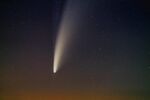Astronomy:2020 HS7
| Discovery[1][2] | |
|---|---|
| Discovered by | Pan-STARRS 2 |
| Discovery site | Haleakala Obs. |
| Discovery date | 27 April 2020 |
| Designations | |
| 2020 HS7 | |
| Minor planet category | NEO · Apollo[3][1] |
| Orbital characteristics[3] | |
| Epoch 9 August 2022 (JD 2459800.5) | |
| Uncertainty parameter 6 | |
| Observation arc | 1 day |
| |{{{apsis}}}|helion}} | 2.904 AU |
| |{{{apsis}}}|helion}} | 0.793 AU |
| 1.849 | |
| Eccentricity | 0.5709 |
| Orbital period | 2.51 yr (918 days) |
| Mean anomaly | 308.988° |
| Mean motion | 0° 23m 31.807s / day |
| Inclination | 4.732° |
| Longitude of ascending node | 38.531° |
| 245.692° | |
| Physical characteristics | |
| Dimensions | a/b = ≥1.04[4] |
| Mean diameter | 4–8 m[5] |
| Rotation period | 2.9945±0.0002 s[4] 2.9938±0.0002 s[4] |
| Absolute magnitude (H) | 29.10±0.36[3] |
2020 HS7 is a very small asteroid classified as a near-Earth object of the Earth-crossing Apollo group. When it was discovered by the Pan-STARRS 2 survey on 27 April 2020, the asteroid was initially calculated to have a 10% chance of impact with Earth before being ruled out by improved orbit determinations from additional observations.[6] Although there is now no risk of impact with Earth, it did make a close approach 42,700 kilometres (26,500 mi) from Earth on 28 April 2020, with a flyby speed of 15.6 kilometres per second (9.7 mi/s) relative to Earth.[3][7][5] The asteroid will not make any close encounters within 1 lunar distance (380,000 km; 240,000 mi) of Earth in the next 100 years.[3]
Observations by Kiso Observatory in Nagano, Japan show that the asteroid rotates extremely rapidly with a rotation period of 3 seconds, making it the fastest-rotating asteroid known (As of 2022).[4] No other near-Earth asteroid of similar size is known to have a rotation period shorter than 10 seconds, which could be attributed to the tangential component of the YORP effect accelerating their rotation far beyond this period.[4] The asteroid exhibits a very small light curve amplitude of 0.07 magnitudes, which either implies a nearly spherical shape or a pole-on rotation during observations.[4]
See also
- List of fast rotators (minor planets)
- List of asteroid close approaches to Earth in 2020
References
- ↑ 1.0 1.1 "2020 HS7". Minor Planet Center. http://www.minorplanetcenter.net/db_search/show_object?object_id=2020+HS7. Retrieved 15 July 2022.
- ↑ "MPEC 2022-F48 : 2022 FD1". Minor Planet Electronic Circular. Minor Planet Center. 28 April 2020. https://minorplanetcenter.net/mpec/K20/K20HL2.html. Retrieved 15 July 2022.
- ↑ 3.0 3.1 3.2 3.3 3.4 "JPL Small-Body Database Browser: (2020 HS7)". Jet Propulsion Laboratory. https://ssd.jpl.nasa.gov/tools/sbdb_lookup.html#/?sstr=2020HS7&view=OPC. Retrieved 29 July 2020.
- ↑ 4.0 4.1 4.2 4.3 4.4 4.5 Beniyama, Jin (2022). "Video observations of tiny near-Earth objects with Tomo-e Gozen". Publications of the Astronomical Society of Japan 74 (4): 877–903. doi:10.1093/pasj/psac043.
- ↑ 5.0 5.1 Bartels, Meghan (5 May 2020). "Tiny asteroid's super-close Earth flyby shows planetary protection in action, scientists say". https://www.space.com/asteroid-2020-hs7-earth-close-flyby-planetary-protection.html.
- ↑ "ESA space situational awareness 2020HS7". European Space Agency. http://neo.ssa.esa.int/search-for-asteroids?tab=summary&des=2020HS7.
- ↑ Malik, Tariq (28 April 2020). "Small asteroid zips safely by Earth just ahead of a larger space rock's flyby". https://www.space.com/small-asteroid-2020-hs7-buzzes-earth-ahead-of-big-space-rock.html.
External links
- 2020 HS7 at NeoDyS-2, Near Earth Objects—Dynamic Site
- Ephemeris · Obs prediction · Orbital info · MOID · Proper elements · Obs info · Close · Physical info · NEOCC
- 2020 HS7 at ESA–space situational awareness
- 2020 HS7 at the JPL Small-Body Database
 |




